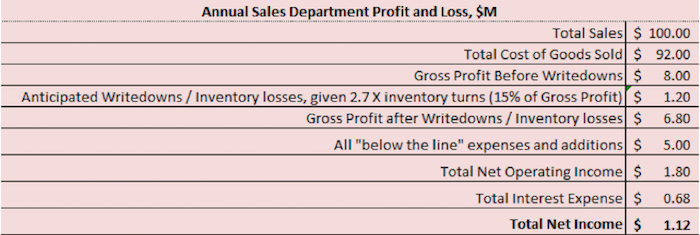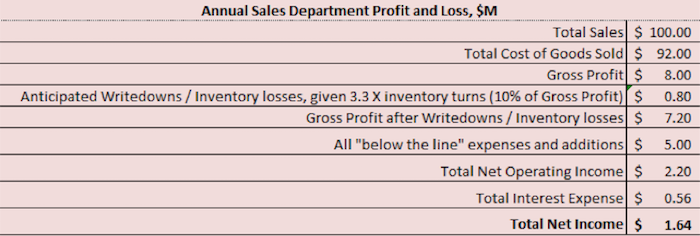Used equipment inventory management is a phrase that can make even seasoned veterans in the equipment industry cringe. Why is that? All we need is the right equipment, at the right price, at the right place, at the right time. Nevertheless, much of the time inventory management remains one part art, two parts science and three parts aggravation!
The Challenge
As equipment dealers, if we sell one new machine, we need to sell 3 or 4 trade-ins before we can know whether we really made any money. And, as used equipment sits on our lots, it gets worse, not better with age.
Furthermore, some of our selling opportunities for used inventory are highly seasonal, such that a given machine can really only be sold at a particular time of year. We often have to wait until the next season, or at least until tax-time, to make a deal on used inventory we just bought.
No wonder we all cringe.
In businesses with physical inventories, poor vs. good inventory management can be the difference between a loss and a profit. Excellent inventory management can have a meaningful impact on cashflow, profitability and customer satisfaction.
Consider the sales department of an agricultural equipment dealer with $100 million in annual sales and 8% gross profit. Net “below the line” expenses equal 5% of sales. This dealer’s effective interest rate is 2%, as he pays 4% interest on half the inventory, with the other half still receiving the manufacturer’s terms.
Here are that dealer’s sample financials, running 2.7X inventory turns, and assuming that he incurs inventory writedowns and losses equal to 15% of gross profit.



Now, as the dealer drives turns from 2.7X to 3.3X, the higher turns reduce writedowns to 10% of gross profit, and reduce interest expenditure too. Plus the yard looks nicer and the salesmen have less stuff to walk around.



This summary of these simple assumptions shows the power of focusing on inventory management at the dealership:

The most recent 15 years in our industry have seen huge changes in used equipment values and customer demand, and dealers have seen their business results fluctuate along with these key factors. Although big volumes obscure a multitude of sins, the lessons of the past four years are hard won, and if a dealer is giving up half a million dollars per year to poor inventory management habits, he’s losing that in good times and bad. Dealers need processes that help profits, regardless of the state of the industry.
7 Tactics for Dealing With Used Inventory
The key insight for dealing with used equipment inventories is this: There is no silver bullet. Dealers must do many different “little” things well. The strategy is the tactics. Consistent, rigorous execution of the steps below constitutes a successful used inventory management strategy.
1. High Quality Data — In Your Business System, and In Your Advertising
When dealing with our inventories, we would grimly joke about aged inventory and “future aged inventory”, which points out that, the first step in getting out of a hole is to stop digging. The best way to reduce your aged inventory in the future is to sell it before it becomes aged.
This requires accurate, well-written and timely information for your used equipment advertising and for your business system. It requires cleaning and detailing the equipment, and then taking great pictures. It requires thinking like a customer as you market the equipment.
Even if you eventually get all the information and pictures you need, there’s the challenge of the amount of time it takes to bring the equipment on your books, get it on the yard, clean it up, take the photos, upload the ads and key the data into the business system. At every step of the way the equipment is aging, you’re paying interest and you may miss the end of a selling season when a bona fide retail customer has a strong need for equipment you own … but aren’t yet in a position to invoice. Anything you can do to compress the time it takes from when you book the trade until the inventory is ready to sell is worth exploring. Increase the sense of urgency in your organization to get used equipment ready to sell. You could improve your turns by approximately 4% just by compressing the time it takes to get inventory ready for sale from 45 to 30 days.
2. Inventory Cost Must Reflect the Reality of the Market
Hope is not a sales strategy. Every now and then, due to some unusual event (a downtime failure or fire, unexpected acquisition of land), you get to exit a used equipment position at a price higher than you anticipated. But this is the exception, not the rule. We all cherish these opportunities, but they are not events on which to build a successful business. Your used inventory needs to be carried on your books between 8-12% below what you expect to get at retail. If it’s not, between the reconditioning bills, the interest expense and paying your staff, you cannot cover the true cost and risks of your used equipment business. If the machine was traded wrong, or if it has deteriorated, swallow hard, grab your red pen and reduce the machine’s cost on your balance sheet.
3. Use Unconventional Channels
For low-dollar aged inventory, or oddball equipment, reach customers who may not think of you by advertising on Craigslist and Ebay. For example, if you’re an agriculture dealer but for some reason you trade a dump truck or wood chipper, you’ll need to find a different way to reach dump truck or wood chipper customers. As a general rule, you can sell anything on Craigslist at some price. Craigslist is a particularly good channel for physically large items, with values between $100 and $10,000. $20,000 tends to be the upper-bound, price-wise, of customers shopping there. Craigslist charges no selling fees, and so is very attractive compared to auctions. Ebay is good for smaller, higher value items like parts and attachments. For both Craigslist and Ebay, excellent pictures and high-quality, informative writing, are key ingredients in your recipe for success.
4. Spiffs & Pricing Programs
Sometimes, to induce salesmen to engage with inventory where they perceive little profit potential, you have to pay a spiff or selling fee. One approach is a matrixed scale ranging from 0.5-2.0% of the sales amount, depending on whether there is a trade-in, and whether the selling price exceeds the full cost or not. Use spiffs to provide support for the sales staff to go beat the bushes and find the customers. Separately, pricing programs are an effort to bring the customers to you, offering special discounted pricing on particular inventory for a defined period of time.
5. Merchandising Tactics: Detail the Equipment, Take Fresh Pictures, Display Prominently, Use Special Signage, and Offer Special Pricing & Financing
Make an effort to draw attention to particular inventory. You can give it a prominent display place. For attractive, physically smaller items like compact tractors and late-model mowers, put the machine on your front porch or in your showroom with a discounted hang-tag price. You’ll want to be sure that the equipment is cleaned and waxed and ready to go to work. If pictures in your ads were taken on a dreary day or before the equipment was detailed, take a fresh set of pictures and upload them to your various online channels. Consider absorbing the freight cost to move a machine that’s not working at one store, to another store where you believe you have a better opportunity.
6. Wholesalers
Develop a network of wholesalers, jockeys, specialty used equipment retailers, used parts dealers and equipment speculators. Understand their businesses and the type of equipment for which they have demand. Then, when you have a machine that fits their profile, call them before you trade it. That way you have a “floor” to your exposure in your used inventory. If you don’t get the machine retailed quickly, call them back and accept their offer. Remember, you’re selling equipment, not collecting it.
7. Auctions
Auctions are a last resort. Whether online or in person, auctions represent capitulation. Auction sales are typically the result of a series of bad events — taking in more than your area can handle, at prices you “hoped” would work in the market, or on equipment for which you didn’t really understand the physical condition before you brought it onto your books. The best thing that can be said about auctions is “that machine is going away from here.” Auctions do provide liquidity, but at a price of 30-50% of your inventory’s value, compared to a retail sale. If you’ve done your job, auctions are for buying, not selling.
Tactics that Make a Strategy
These 7 actionable tactics, taken together, offer a comprehensive approach to manage used inventory and to address inventory aging. There is no single step or single tool to manage the challenges of physical inventory in dealership businesses, but if dealers employ all of these, all the time, they’ll be way ahead of their competition. As usual, all it takes is doing it.






